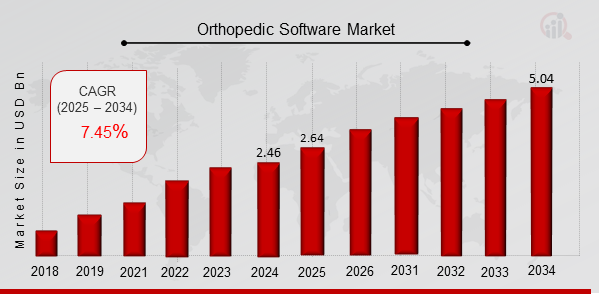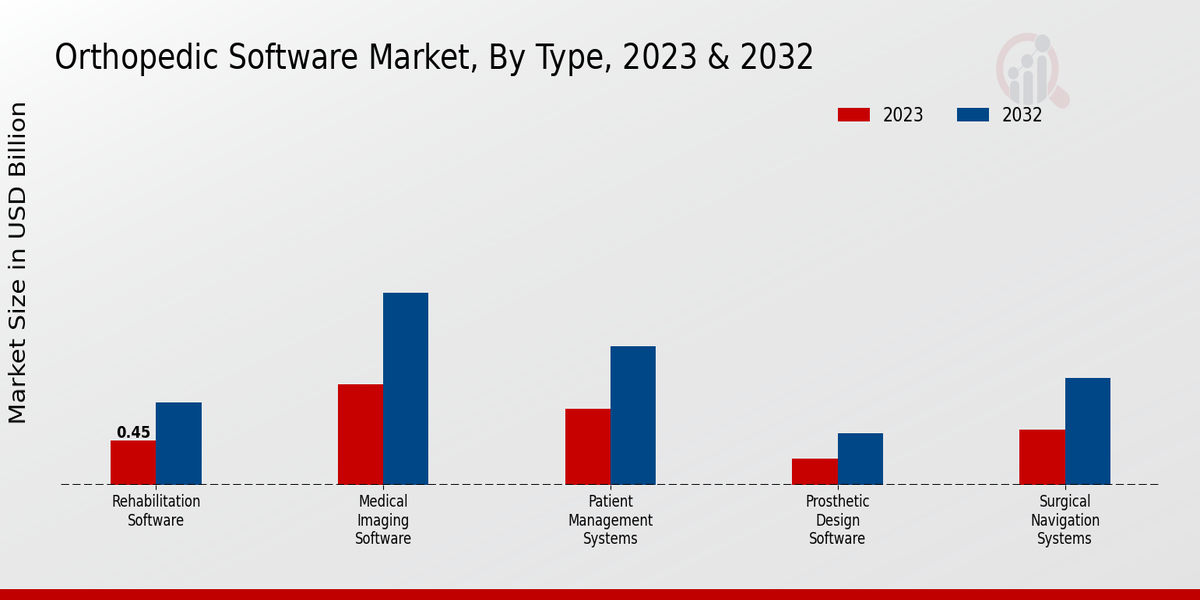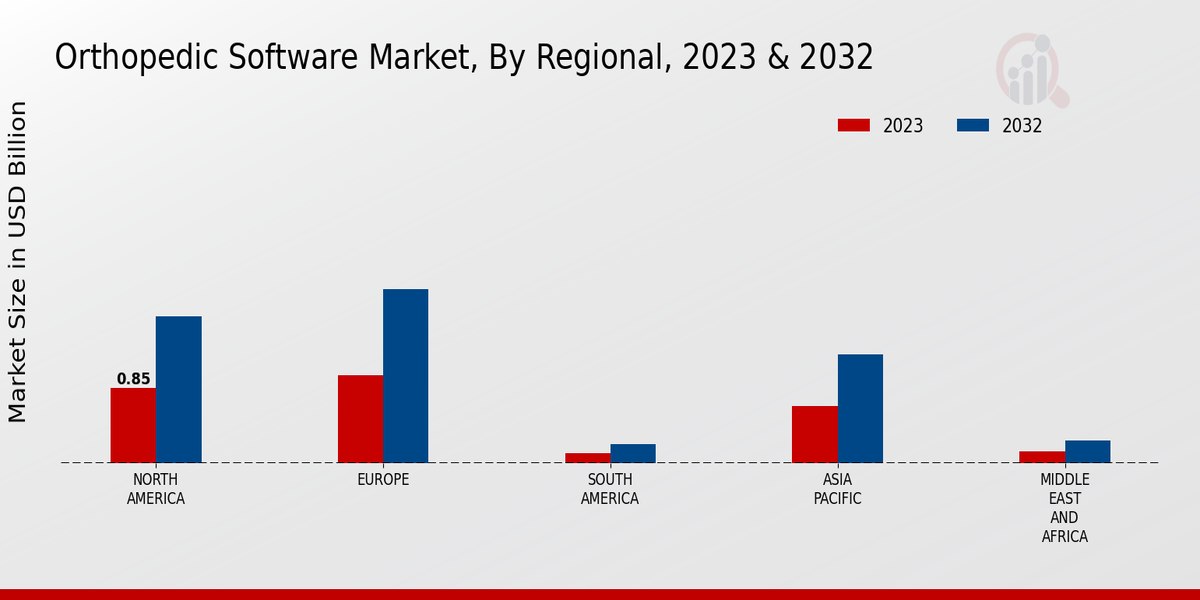Orthopedic Software Market Overview
As per MRFR analysis, the Orthopedic Software Market Size was estimated at 2.46 (USD Billion) in 2024. The Orthopedic Software Market Industry is expected to grow from 2.64 (USD Billion) in 2025 to 5.04 (USD Billion) till 2034, at a CAGR (growth rate) is expected to be around 7.45% during the forecast period (2025 - 2034).
Key Orthopedic Software Market Trends Highlighted
Key market drivers for orthopedic software include the rising prevalence of musculoskeletal disorders, increasing demand for personalized treatments, and advancements in medical imaging technology. Opportunities lie in the integration of artificial intelligence and machine learning for improved diagnosis and treatment planning. The trend towards cloud-based orthopedic software enables remote patient monitoring and collaboration among healthcare professionals.
Additionally, the adoption of robotic surgery and 3D printing in orthopedics is expected to further drive market growth.

Source: Primary Research, Secondary Research, MRFR Database and Analyst Review
Orthopedic Software Market Drivers
Growing Demand for Personalized Treatment Plans
The increasing prevalence of chronic orthopedic conditions, such as osteoarthritis and osteoporosis, is driving the demand for personalized treatment plans. Orthopedic software enables healthcare providers to create customized treatment plans based on individual patient data, including medical history, imaging results, and lifestyle factors. This tailored approach improves patient outcomes and reduces the risk of complications.
Additionally, the growing adoption of value-based healthcare models is incentivizing healthcare providers to invest in technologies that improve patient care and reduce costs.Orthopedic software plays a crucial role in achieving these goals by optimizing treatment plans and reducing unnecessary interventions.
Advancements in Artificial Intelligence and Machine Learning
The integration of artificial intelligence (AI) and machine learning (ML) algorithms into orthopedic software is revolutionizing the field. AI-powered software can analyze vast amounts of data to identify patterns and trends, which can aid in diagnosis, treatment planning, and surgical navigation. ML algorithms can be trained on historical patient data to predict outcomes and personalize treatment recommendations. These advancements enhance the accuracy and efficiency of orthopedic procedures, leading to better patient outcomes and reduced recovery times.
Rising Popularity of Remote Patient Monitoring
The growing adoption of remote patient monitoring (RPM) is creating new opportunities for orthopedic software. RPM systems allow healthcare providers to monitor patient's progress and recovery remotely, reducing the need for in-person visits. Orthopedic software can integrate with RPM devices to collect data on patient mobility, pain levels, and other vital signs. This data can be used to adjust treatment plans, identify potential complications early on, and improve patient engagement.
The convenience and cost-effectiveness of RPM are driving its adoption, which is, in turn, fueling the demand for orthopedic software that supports remote monitoring capabilities.
Orthopedic Software Market Segment Insights
Orthopedic Software Market Type Insights
Surgical Navigation Systems, Patient Management Systems, Medical Imaging Software, Prosthetic Design Software, and Rehabilitation Software are the five primary types of Orthopedic Software Market. Patient Management Systems streamline patient data management, improving efficiency and care coordination, contributing to the segment's expansion. Medical Imaging Software is crucial for visualizing and analyzing medical images, aiding in diagnosis and treatment planning. This segment is anticipated to grow due to advancements in imaging technologies and the increasing adoption of AI-powered image analysis tools.
Prosthetic Design Software assists in designing and manufacturing customized prosthetics, leading to improved patient outcomes and segment growth. Rehabilitation Software aids in post-operative rehabilitation, providing personalized exercise plans and progress tracking. This segment is expected to expand as the demand for effective rehabilitation solutions grows. The increasing prevalence of orthopedic conditions, technological advancements, and the rising geriatric population are key factors driving the Orthopedic Software Market growth. Furthermore, government initiatives and favorable reimbursement policies support market expansion.However, data security concerns and the high cost of implementation may pose challenges.

Source: Primary Research, Secondary Research, MRFR Database and Analyst Review
Orthopedic Software Market Application Insights
The Global Orthopedic Software Market segmentation by Application is expected to witness significant growth in the coming years. The key application segments include Joint Replacement Surgery, Spine Surgery, Trauma Surgery, Sports Medicine, and Pediatric Orthopedics. Joint Replacement Surgery is expected to dominate the market, accounting for a major share of the revenue. The segment is driven by the rising incidence of osteoarthritis and other joint disorders, leading to an increasing demand for joint replacement procedures. Spine Surgery is another major segment, with a significant contribution to the market growth.
The increasing prevalence of spinal disorders, such as back pain and spinal stenosis, is fueling the demand for spine surgeries. Trauma Surgery is also a key application segment, driven by the rising number of accidents and injuries. Sports Medicine is another growing segment, with increasing participation in sports activities and the rising incidence of sports-related injuries. Pediatric Orthopedics is expected to witness steady growth, driven by the growing focus on early diagnosis and treatment of orthopedic conditions in children.
Orthopedic Software Market End-User Insights
The End-User segment of the Global Orthopedic Software Market holds significant importance, with each sub-segment contributing to the overall market growth. Hospital clinics account for a substantial portion of the market revenue, driven by the rising prevalence of orthopedic surgeries and the need for advanced software solutions to manage patient data, optimize surgical procedures, and improve patient outcomes. Ambulatory Surgery Centers are also witnessing a surge in demand for orthopedic software as they offer convenient and cost-effective alternatives to traditional hospital settings.
Orthopedic Specialty Centers, dedicated exclusively to orthopedic care, leverage orthopedic software to enhance patient care and streamline operations. Physical Therapy Centers utilize orthopedic software for rehabilitation and recovery tracking, enabling personalized treatment plans and improved patient monitoring. Research Institutions, including universities and medical centers, employ orthopedic software for data analysis, clinical trials, and the development of innovative orthopedic treatments.
Orthopedic Software Market Business Model Insights
The orthopedic software market is segmented based on business model into cloud-based, on-premises, subscription-based, and perpetual license. Among these, the cloud-based segment is anticipated to hold the largest share of the global orthopedic software market revenue in 2023. The growth of this segment can be attributed to the increasing adoption of cloud computing solutions by healthcare providers due to their benefits, such as cost-effectiveness, scalability, and flexibility. Additionally, the growing popularity of mobile health applications is driving the demand for cloud-based orthopedic software solutions.
The on-premises segment is expected to witness a steady growth rate during the forecast period. The perpetual license segment is anticipated to hold a significant share of the market due to the upfront payment model, which provides perpetual access to the software. The subscription-based segment is expected to grow at a significant rate during the forecast period due to the increasing adoption of software-as-a-service (SaaS) models by healthcare providers.
Orthopedic Software Market Technology Insights
The Global Orthopedic Software Market segmentation by Technology is categorized into Artificial Intelligence, Machine Learning, 3D Printing, Wearable Devices, and Haptic Technology. Artificial Intelligence is poised to hold the largest share of the market in 2023, owing to its increasing use in preoperative planning, surgical navigation, and postoperative rehabilitation. Machine Learning algorithms are being used to develop predictive models for orthopedic conditions, which is expected to drive the growth of this segment in the coming years.
3D Printing is gaining traction in the market due to its ability to create custom-made implants and prosthetics.Wearable Devices are being used to monitor patient recovery and provide remote rehabilitation support. Haptic Technology is being used to develop surgical simulators and training tools, which is expected to contribute to the growth of this segment in the future.
Orthopedic Software Market Regional Insights
The regional segmentation of the Global Orthopedic Software Market presents distinct market dynamics and growth opportunities across key regions. North America holds a significant market share due to the presence of well-established healthcare infrastructure, technological advancements, and high adoption rates of orthopedic software solutions. Europe follows closely with a growing demand for orthopedic software, driven by increasing healthcare expenditure and aging populations. The Asia-Pacific (APAC) region is expected to witness substantial growth in the coming years, owing to rising healthcare investments, government initiatives, and the increasing prevalence of orthopedic conditions.
South America and the Middle East and Africa (MEA) regions also offer potential growth opportunities due to the expanding healthcare sector and the growing demand for orthopedic software solutions. The market growth in these regions is attributed to factors such as increasing healthcare awareness, improving healthcare infrastructure, and rising disposable income levels.

Source: Primary Research, Secondary Research, MRFR Database and Analyst Review
Orthopedic Software Market Key Players And Competitive Insights
Major players in the Orthopedic Software Market industry are continuously working to enhance the capabilities of their offerings. Leading Orthopedic Software Market players are focusing on developing innovative solutions that can provide better insights into patient data and improve surgical outcomes. Orthopedic Software Market development is being driven by the increasing adoption of AI and machine learning in healthcare.
AI-powered solutions can help automate tasks, improve accuracy, and provide real-time insights. The Orthopedic Software Market Competitive Landscape is expected to remain competitive in the coming years, with new entrants and established players vying for market share.Stryker is a leading provider of Orthopedic Software Market products and services.
The company offers a comprehensive suite of software solutions that cover the entire spectrum of orthopedic care, from pre-operative planning to post-operative rehabilitation. Stryker's software is used by hospitals, clinics, and orthopedic surgeons around the world. The company has a strong track record of innovation and is constantly investing in new technologies to improve its products. Stryker is well-positioned to continue to be a leader in the Orthopedic Software Market.Medtronic is another major player in the Orthopedic Software Market.
The company offers a wide range of software solutions for orthopedic surgeons, including preoperative planning, intraoperative navigation, and postoperative assessment. Medtronic's software is used by hospitals, clinics, and orthopedic surgeons around the world. The company has a strong focus on research and development and is constantly investing in new technologies to improve its products. Medtronic is well-positioned to continue to be a leader in the Orthopedic Software Market.
Key Companies in the Orthopedic Software Market Include
- Smith Nephew
- Medtronic
- Barco
- Arthrex
- Sectra
- Philips Healthcare
- GE Healthcare
- Canon Medical Systems
- Johnson Johnson
- Siemens Healthineers
- Agfa HealthCare
- Cerner
- Stryker
- Zimmer Biomet
- Brainlab
- Materialise
Orthopedic Software Market Industry Developments
The global orthopedic software market is projected to reach USD 4.07 billion by 2032, exhibiting a CAGR of 7.45% during the forecast period (2024-2032). The growth is attributed to factors such as the rising prevalence of musculoskeletal disorders, increasing demand for personalized surgical planning, and technological advancements in software solutions. Key market players are focusing on developing innovative solutions that enhance surgical accuracy, reduce recovery time, and improve patient outcomes.
Recent developments include the integration of artificial intelligence (AI) and machine learning (ML) to automate tasks, streamline workflows, and provide personalized treatment plans. The market is also witnessing the emergence of cloud-based solutions that offer remote access and data-sharing capabilities.
Orthopedic Software Market Segmentation Insights
Orthopedic Software Market Type Outlook
- Surgical Navigation Systems
- Patient Management Systems
- Medical Imaging Software
- Prosthetic Design Software
- Rehabilitation Software
Orthopedic Software Market Application Outlook
- Joint Replacement Surgery
- Spine Surgery
- Trauma Surgery
- Sports Medicine
- Pediatric Orthopedics
Orthopedic Software Market End-User Outlook
- Hospitals Clinics
- Ambulatory Surgery Centers
- Orthopedic Specialty Centers
- Physical Therapy Centers
- Research Institutions
Orthopedic Software Market Business Model Outlook
- Cloud-based
- On-premises
- Subscription-based
- Perpetual License
Orthopedic Software Market Technology Outlook
- Artificial Intelligence
- Machine Learning
- 3D Printing
- Wearable Devices
- Haptic Technology
Orthopedic Software Market Regional Outlook
- North America
- Europe
- South America
- Asia Pacific
- Middle East and Africa
| Report Attribute/Metric |
Details |
|
Market Size 2024
|
2.46 (USD Billion)
|
|
Market Size 2025
|
2.64 (USD Billion)
|
|
Market Size 2034
|
5.04 (USD Billion)
|
|
Compound Annual Growth Rate (CAGR)
|
7.45 % (2025 - 2034)
|
|
Report Coverage
|
Revenue Forecast, Competitive Landscape, Growth Factors, and Trends
|
|
Base Year
|
2024
|
|
Market Forecast Period
|
2025 - 2034
|
|
Historical Data
|
2020 - 2024
|
| Market Forecast Units |
USD Billion |
| Key Companies Profiled |
Smith Nephew, Medtronic, Barco, Arthrex, Sectra, Philips Healthcare, GE Healthcare, Canon Medical Systems, Johnson Johnson, Siemens Healthineers, Agfa HealthCare, Cerner, Stryker, Zimmer Biomet, Brainlab, Materialise |
| Segments Covered |
Type, Application, End-User, Business Model, Technology, Regional |
| Key Market Opportunities |
Advanced data analytics Cloud-based offerings Patient-centric software Personalized treatment plans Surgical planning and navigation |
| Key Market Dynamics |
Increasing prevalence of orthopedic diseases, technological advancements, rising demand for customized implants, growing adoption of AI and ML favorable government initiatives |
| Countries Covered |
North America, Europe, APAC, South America, MEA |
Frequently Asked Questions (FAQ) :
The global orthopedic software market is expected to reach USD 5.04 billion by 2034, exhibiting a CAGR of 7.45% from 2025 to 2034.
North America is expected to account for the largest market share due to the presence of major market players, high healthcare expenditure, and rising prevalence of orthopedic conditions.
Major applications include preoperative planning, surgical navigation, implant design, and rehabilitation.
Key competitors include Stryker, Medtronic, Siemens Healthineers, Materialise, and Brainlab.
Factors driving growth include the rising prevalence of orthopedic conditions, technological advancements, increasing healthcare expenditure, and growing demand for personalized treatments.
Challenges faced include the high cost of software, lack of interoperability, and stringent regulatory requirements.
Opportunities for growth lie in emerging markets, advancements in artificial intelligence, and personalized medicine.
Key trends include cloud-based solutions, integration of AI, and the use of virtual reality for surgical planning.
The Global Orthopedic Software Market is expected to grow at a CAGR of 7.45% from 2025 to 2034.
Key segments include software type, application, end-user, and geography.

















